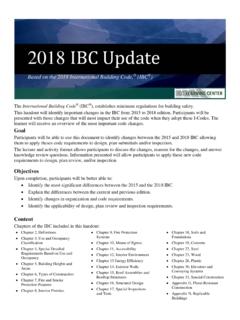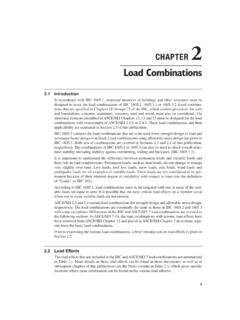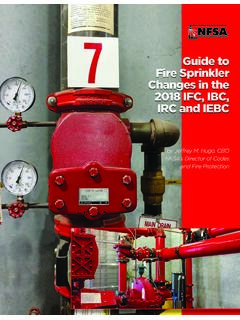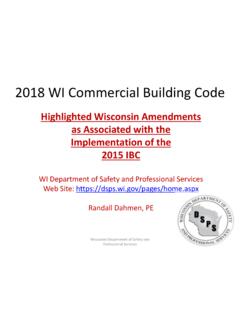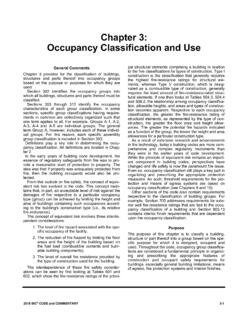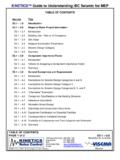Transcription of Storm Shelter Design: Overview of IBC and ICC-500 …
1 Storm Shelter Design: Overview of IBC and ICC-500 RequirementsIncluding Safe Rooms and Significant Changes in ICC 500-2020 University of MinnesotaStructural Engineering Webinar1/26/2021 Marc L. Levitan, Research EngineerNational Windstorm Impact Reduction ProgramNational Institute of Standards and TechnologyChair, Storm Shelter Standards Committee: ICC 500-2008 Chair, Structures/ chapter 3 Work Group: ICC 500-2014 Chair, Storm Shelter Standards Committee: ICC 500-2020 Chair, ASCE 7-22 Tornado Task CommitteeCo-Chair, ASCE/AMS Std on Wind Speed Estimation in Tornadoes Cmte| 2|Design of Storm Shelters| 2|Design of Storm SheltersAcknowledgements International Code Council ICC 500 Committee Secretariat Staff Dave Bowman (2008 and 2014 eds) and Kim Paarlberg (2020 ed.) ICC 500 committee members and interested parties FEMA, Building Science & Hazard Mitigation Slides with FEMA logo at bottom used with permission National Storm Shelter Association NIST Many collaborators over the yearsSource: Marc Levitan / LSU Hurricane Center Presentation Outline Shelter /Safe Room Terminology and Purpose Shelter Design Considerations Development of the Shelter Standard Structural Provisions, incl.
2 Wind Loads Pressure and Impact Testing Model Building Code and State Requirements for Storm Shelters FEMA Safe Room Criteria FEMA Mitigation Grants (help pay for safe rooms!) Key Changes in ICC 500-2020 ASCE 7-22: Tornado Loads for Conventional Buildings Additional Resources| 3|Design of Storm SheltersPrimary Focus on Tornado Shelters| 4|Design of Storm Shelters| 4|Design of Storm SheltersTerminologyCommunity ShelterCommunity Safe RoomRefuge AreaBest Available Refuge AreaSafe RoomPublic ShelterSevere Weather Shelter AreaEmergency ShelterShelter-in-placeRed Cross ShelterIn-residence shelterStand-alone ShelterResidential ShelterStorm Shelter | 5|Design of Storm Shelters| 5|Design of Storm SheltersTerminology Storm Shelter . A building, structure or portion thereof, constructed in accordance with ICC 500, designated for use during a tornadoes, hurricanes, and other severe windstorms.
3 SAFE ROOM. An interior room, space within a building, or entirely separate building, designed and constructed to provide near absolute life-safety protection for its occupants from tornadoes or hurricanes. Safe rooms are designed and constructed to meet the criteria in FEMA P-361 or FEMA P-320.(ICC 500-2020)(FEMA P-361, 3rded.)| 6|Design of Storm Shelters| 6|Design of Storm SheltersTerminology BEST AVAILABLE REFUGE AREA. Building area (or areas) that has been determined by an RDP to be least vulnerable to the life threatening effects of extreme-wind incidents relative to other building areas. These areas were not specifically designed as tornado safe rooms, and as a result, occupants may be injured or killed during a tornado. However, people in best available refuge areas are less likely to be injured or killed than people in other areas of a building Tornado Protection: Selecting Refuge Areas in Buildings, FEMA P-431, Second Edition / October 2009| 7|Design of Storm Shelters| 7|Design of Storm SheltersICC 500: PurposeThe purpose of this standard is to establish minimum requirements to safeguard the public health, safety and general welfare relative to the design, construction and installation of Storm shelters constructed for protection from tornadoes, hurricanes and other severe windstorms.
4 This standard is intended for adoption by government agencies and organizations for use in conjunction with applicable codes to achieve uniformity in the technical design and construction of Storm 500-2020| 8|Design of Storm Shelters| 8|Design of Storm SheltersFEMA 361: PurposeThe purpose and scope of FEMA P-361 is to provide guidance including emergency managementconsiderations for safe rooms that provide near-absolute P-361, protection:Based on our current knowledge of tornadoes and hurricanes, the occupants of a safe room built according to FEMA P-361 will have a very high probability of being protected from injury or death.| 9|Design of Storm Shelters| 9|Design of Storm SheltersThis Standard Hopes to Prevent : Marc Levitan / LSU Hurricane Center Hattie A. Watts Elementary SchoolPatterson LAHurricaneAndrew, 1992| 10|Design of Storm Shelters| 10|Design of Storm SheltersAnd : FEMAS ource: FEMAE nterprise High SchoolEnterprise ALMarch 1 2007 Tornado| 11|Design of Storm Shelters| 11|Design of Storm SheltersAnd : NOAAS chool ShelterNorth CarolinaHurricane Fran, 1995| 12|Design of Storm Shelters| 12|Design of Storm SheltersAnd : Marc Levitan / LSU Hurricane Center Source: FEMAT urner Agriciviccenter Arcadia FLHurricane Charley, 2004| 13|Design of Storm Shelters| 13|Design of Storm SheltersAnd : NOAA/National Weather ServiceLincoln High SchoolMcCLellenvilleSCHurricane Hugo, 1989| 14|Design of Storm Shelters| 14|Design of Storm SheltersAnd.
5 Marc Levitan / NISTP laza Towers Elementary School Moore OK May 20, 2013 Tornado| 15|Design of Storm Shelters| 15|Design of Storm SheltersAnd Towers Elementary School Moore OK May 20, 2013 TornadoSource: FEMA In-Residence Safe RoomJoplin, MO, May 22, 2011 Winston County Commission Community Safe RoomArley, AL, November 30, 2016 Source: FEMAS helter and Safe Room PurposeFEMA P-361 1-Day Training -Introduction and Module A1 Success from Joplin, MO TornadoResidential Safe Room Installed in garage Passed Texas Tech testing 2 occupants survived Testimonial video: P-361 1-Day Training -Introduction and Module A118 Success from Joplin, MO TornadoTrack Record of Success FEMA publications presenting design and construction guidance for both residential and community safe rooms have been available since 1998.
6 Since that time, thousands of safe rooms have been built, and a growing number of these safe rooms have already saved lives in actual events. There has not been a single reported failure of a safe room constructed to FEMA criteria. Source: FEMA P-361, 3rdedSimilarly, failures of tornado shelters constructed to the ICC 500 standard (first published in 2008) have not been reported.| 20|Design of Storm Shelters| 20|Design of Storm SheltersICC 500: ScopeThis standard applies to the design, construction, installation and inspection of Storm shelters constructed for the purpose of providing protection from tornadoes, hurricanesand other severe windstorms. Storm shelters shall be constructed as either separate, detached buildings or rooms or spaces within new or existing buildings. Design of facilities for use as emergency shelters after the Storm is outside the scope of this 500-2020 Presentation Outline Shelter /Safe Room Terminology and Purpose Shelter Design Considerations Development of the Shelter Standard Structural Provisions, incl.
7 Wind Loads Pressure and Impact Testing Model Building Code and State Requirements for Storm Shelters FEMA Safe Room Criteria FEMA Mitigation Grants (help pay for safe rooms!) Key Changes in ICC 500-2020 ASCE 7-22: Tornado Loads for Conventional Buildings Additional Resources| 21|Design of Storm SheltersPrimary Focus on Tornado Shelters| 22|Design of Storm Shelters| 22|Design of Storm SheltersDifferences Between Tornado andHurricane Shelter Design Considerations Numerous and Significant Hazards Warning Time Duration of Stay | 23|Design of Storm Shelters| 23|Design of Storm SheltersTornado Extreme Winds Windborne Debris Laydown, Falling Debris, and Collapse Hazards Atmospheric Pressure Change Flash Flooding LightningHurricane Extreme Winds and Tornadoes Windborne Debris Laydown, Falling Debris, and Collapse Hazards Extreme Rain (roof load)
8 Storm Surge Flooding and Waves Inland Flooding FloodborneDebris LightningPrimary Hazards Fire following damage Shelter exits blocked by debrisFollow-on HazardsDifferences Between Tornado andHurricane Shelter Design Considerations| 24|Design of Storm Shelters| 24|Design of Storm SheltersDifferences Between Tornado andHurricane Shelter Design ConsiderationsTornado MinutesHurricane DaysTornado Unlocking of Shelter doors Shelter in place or adjacent building Rate of ingress to Shelter space Signage to identify Shelter locationHurricane Travel to Shelter Accessibility of Shelter from transportation network Parking Backup power, water, sanitationWarning TimeRelated ConsiderationsCommunity Shelters| 25|Design of Storm Shelters| 25|Design of Storm SheltersDifferences Between Tornado andHurricane Shelter Design ConsiderationsTornado Minutes to HoursHurricane Hours to DaysTornado Space required per person on the order of 5 sq ftHurricane Space required per person on the order of 20 sq ft Managed facilities Utilities (water, electricity, food handling)Duration of StayRelated ConsiderationsCommunity SheltersPresentation Outline Shelter /Safe Room Terminology and Purpose Shelter Design Considerations Development of the Shelter Standard Structural Provisions, incl.
9 Wind Loads Pressure and Impact Testing Model Building Code and State Requirements for Storm Shelters FEMA Safe Room Criteria FEMA Mitigation Grants (help pay for safe rooms!) Key Changes in ICC 500-2020 ASCE 7-22: Tornado Loads for Conventional Buildings Additional Resources| 26|Design of Storm SheltersPrimary Focus on Tornado Shelters| 27|Design of Storm Shelters| 27|Design of Storm SheltersStorm Shelter Standard Initial development began in Spring 2003 as a collaborative effort between International Code Council National Storm Shelter Association Federal Emergency Management Agency 1st edition: 2008 2nd edition: 2014 2nd edition + Commentary: 2016 3rdedition: 2020 3rdedition + Commentary: early 2021 ICC/NSSA Standard for the Design and Construction of Storm Shelters| 28|Design of Storm Shelters| 28|Design of Storm SheltersICC Standard Consensus Process Form balanced committee Gather input from scientific, technical, and user communities Develop draft standard Publish draft standard for public comment Formal, public committee meeting to address all comments ANSI approval Publish standard Available for incorporation in building codes Available for direct adoption by states or communities| 29|Design of Storm Shelters| 29|Design of Storm Shelters2008 Shelter Standard Committee Members Balanced Committee General Interest, Producer Interest, User Interest Committee Makeup Code Officials Emergency Managers and Planners Federal (FEMA)
10 And State Officials Industry NAHB, NSSA, PCA, NCMA, AISI, Ingersoll Rand, RemagenSafe Rooms University faculty members: LSU, Texas Tech Consultants and Users URS, JDH Consulting, PBA Architects, IBHS Included a number of structural engineers And several wind engineers John Holmes, Ernst Kiesling, Marc Levitan, Tim Reinhold Numerous Friends of the Committee Particularly from industry, testing labs, and FEMA| 30|Design of Storm Shelters| 30|Design of Storm SheltersPrimary Source Documents/References NSSA Industry Standard Standard for the Design, Construction, and Performance of Storm Shelters primarily addresses residential shelters FEMA 320: Taking Shelter from the Storm : Building a Safe Room Inside Your House in-residence shelters FEMA 361: Design and Construction of Community Storm Shelters standalone or as part of a larger building ARC4496: Guidelines for Hurricane Evacuation Shelter Selection addresses community shelters selection of existing buildings Florida public Shelter design criteria known as Enhanced Hurricane Protection Area (EHPA) criteria section , Florida Building Code| 31|Design of Storm Shelters| 31|Design of Storm SheltersICC 500: Scope Hurricane and Tornado Shelters Residential and Community Shelters Includes Considerations for Architectural Structural Mechanical Electrical Plumbing Other| 32|Design of Storm Shelters| 32|Design of Storm SheltersICC 500.
